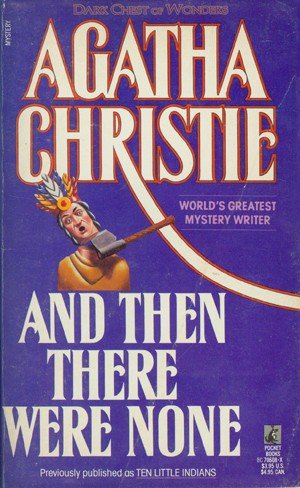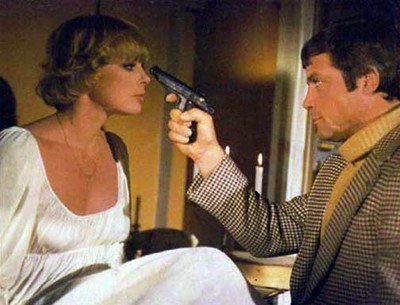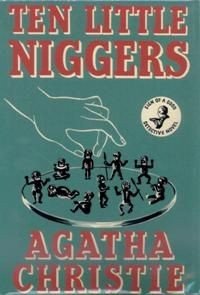

This classic novel doesn’t need much by way of introduction – it’s just been voted the most popular Agatha Christie book ever. With over 100 million copies sold worldwide, it’s said to be the best-selling crime novel of all time and is generally regarded as the most technically accomplished Golden Age mystery.
First published in 1939, it was adapted for stage by Christie herself in 1943, albeit with a happier ending. The original was considered too grim during World War II, although it follows the good old tradition of Shakespeare’s tragedies, strewn with corpses.
The book is also notorious for its controversial original title, Ten Little Niggers (or Indians), named after a vaudeville song which is key to the plot. This title was soon deemed too offensive and changed to And Then There Were None. That has not prevented it from being translated using words equating to ‘blacks’ or ‘indians’ in other languages. Another distinguishing feature is that it does not feature either Miss Marple nor Hercule Poirot, and in fact it’s not cosy at all. It’s a chilling psychological thriller with no likeable characters and no comfortable solutions. Re-reading it can be rewarding too. You may not have forgotten its ingenious solution, which really shocks first-time readers, but you will be gripped anew by the claustrophobic atmosphere and the masterly manipulation of a broad cast of characters.
This is the epitome of the locked-room or country mansion mystery, even though the actual location is a whole island, cut off from the mainland by a storm. Ten unrelated strangers are invited to spend the weekend on this island just off the English coast. Once there, they realise that none of them know their unseen host, who has identified himself only as AN Owen. Using a prerecorded gramophone, Owen accuses each of his guests of past murders that the law was unable to punish, and promises to avenge the victims.
The first guest dies soon afterwards of poisoning, and others swiftly follow. The remaining guests realise that the killer is murdering them according to the sinister nursery rhyme displayed in each of their rooms. After fruitlessly searching the island for the mysterious Mr Owen, they have to acknowledge that the unknown assailant is in fact one of their number. The twin pyschological torments of guilt and suspicion are recorded in just enough detail in this short but satisfying volume.

How to explain its perennial popularity? It’s a gripping page-turner, of course, and there is the shock value of its plot twist for those unfamiliar with the story. Even the police, who only makes a brief appearance at the end, are puzzled and it’s only the confession in a bottle in the very last chapter that spells out the exact solution. The characters are a little stereotypical, but Christie does a great job at differentiating the individual traits of a fairly large cast. The internal monologues cunningly disguise the real culprit, yet give us the feeling that the author is putting all the cards on the table.
But it’s not all fun and games. Besides the usual clock-ticking device of finding a killer before he finds you, the book also grapples with the idea of justice. Is it ever okay for someone to take justice into his or her own hands? Christie suggests that guilt is a spectrum, rather than a clear on/off switch. There are different levels of criminality. According to the murderer, the deaths happen from least guilty to most guilty. Yet remorse seems to have little to do with it – as the person who ran over and killed two children by driving too fast doesn’t feel the slightest bit guilty, while others seem haunted by their victims.

Christie herself admitted that this was one of the most difficult books she ever wrote: “I had written the book… because it was so difficult to do that the idea had fascinated me. Ten people had to die without it becoming ridiculous or the murderer being obvious. I wrote the book after a tremendous amount of planning, and I was pleased with what I had made of it. It was clear, straightforward, baffling, and yet had a perfectly reasonable explanation…”
Re-reading this book, it becomes apparent why she remains the queen of crime fiction even after all these years. You will appreciate the excellent pacing: enough detail to make it compelling, yet short and compelling, pushing you on to read in a single sitting.
The Agatha Christie Theatre Company is touring the UK until the end of November with the author’s original stage version to mark the 125th anniversary of Christie’s birth and the company’s own 10th birthday. Film adaptations of the book – by directors René Claire in 1945, George Pollock in 1965 (set in a mountain resort in Austria), and Peter Collinson in 1974 (set in the Iranian desert) – generally favour the upbeat ending. The trailer for the latter is below.
The Russian version by Stanislav Govorukhin (1987) is the one that sticks most closely to the book – a minor masterpiece of storytelling and acting.
And Then There Were None is currently being filmed as a three-parter for BBC and will be aired later in 2015, with a star-studded cast including stalwarts such as Sam Neill, Charles Dance and heartthrob Aiden Turner. Too many novels and game shows have been inspired by the premise to be mentioned individually, but books you can also try include The Corpse with the Platinum Hair by Cathy Ace, A Maze of Death by Philip K Dick, The Westing Game by Ellen Raskin and Stranger at Sunset by Eden Baylee.








An excellent piece about a rightly much-admired book. I am flattered to have my own work mentioned alongside it. Quite nervous, but flattered! Thank you. 🙂